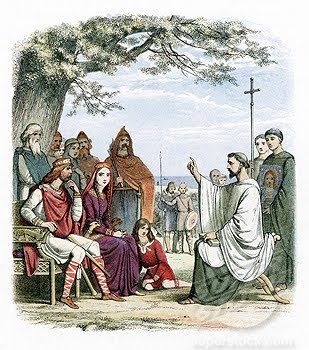 St. Augustine of Canterbury
St. Augustine of Canterbury
Image: Longbows & Rosary Beads
(EWTN) When Pope Gregory began to plan for the evangelism of England, the land was still largely pagan although in the Southwest, there were remnants of earlier missionary efforts. To lead this important mission, Pope Gregory chose Augustine–Nothing much is known of him until the year 596 when with a party of 40 Benedictine Monks, he set out Northwards from Rome according to Franciscan Media to evangelize the Anglo-Saxons in England.
Upon reaching Provence, the Monks accompanying Augustine grew fearful of the dangers that lay ahead, alarming stories were being told of the ferocity of the Pagans and the hazards of crossing the treacherous waters of the English Channel.
Augustine subsequently returned to Rome and to Pope Gregory only to be assured by him that the fears of the Monks were groundless–Augustine again set out. This time the group crossed the English Channel and landed in the territory of Kent, ruled by King Ethelbert, a pagan married to a Christian, Bertha Ethelbert who received them kindly and set up a residence for them in Canterbury.
After King Ethelbert listened carefully to the Monks teaching, he gave them permission to evangelize his subjects–One year later on Pentecost in 597 King Ethelbert converted and was baptized.
Subsequent to this promising start, Augustine returned to Provence to be consecrated Bishop in France and then returned to Canterbury where he set up his See.
Now a Bishop, in 603 Augustine constructed a Church and Monastery on property given by King Ethelbert–these structures formed the nucleus for the metropolitan cathedral–they were destroyed by fire in 1067 and the present cathedral begun by Lanfranc in 1070 stands on its site. As the Christian faith spread, additional Sees were established at London and Rochester.
Work was often slow and Bishop Augustine did not always meet with success. Attempts to reconcile the Anglo-Saxon Christians with the Briton Christians (who had been driven into Western England by the Anglo-Saxon invaders) ended in dismal failure.
While the Briton Christians were sound in fundamental doctrine, Bishop Augustine failed to convince them to give up certain Celtic customs at variance with Rome and to forget their bitterness with the Anglo-Saxon Christians.
Laboring patiently, Bishop Augustine wisely heeded the missionary principles–quite enlightened for his time, suggested by Pope Gregory:
- Purify rather than destroy pagan temples and customs;
- Allow pagan rites and festivals be transformed into Christian Feasts;
- Retain local customs as far as possible.
Bishop Augustine’s last years were spent in spreading and consolidating the Christian faith in the short eight years since his arrival, which would eventually bear great fruit, leaving the continuation of his work to others long after his death in 604 — Bishop Augustine of Canterbury can truly be called the ‘Apostle of England’ for which he is the Patron Saint.
Related: For Today’s Holy Scripture Readings for the Memorial of St. Augustine of Canterbury, Visit: -USCCB